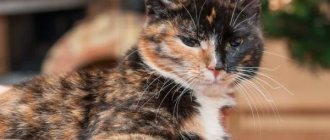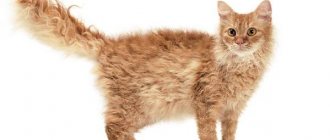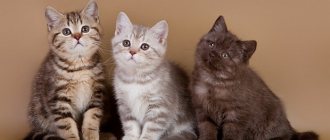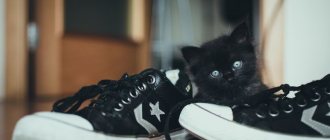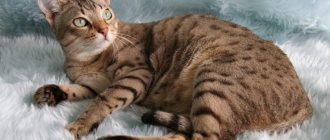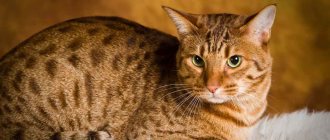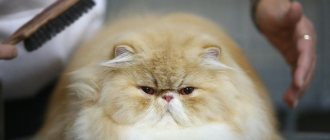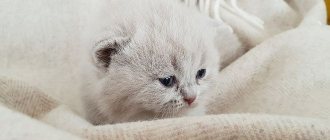The British marbled cat is considered one of the most ancient and beloved breeds. The animal has an interesting origin story. The future owner should familiarize himself with the standard of the reference representatives, know what shades of merle color exist, what is the character and health status of the cat. The owner also needs to master the skills of care and feeding, and if you plan to visit an exhibition, study the issues of reproduction.
According to breeders, a British merle cat is considered the most valuable and expensive among the representatives of its breed.
British merle color: features of the breed
The first cat show, held in 1879 in London, was attended by the British. Since then, plush animals have gained considerable popularity, as kittens were actively bought by foreign breeders and taken outside the country. The breed, despite its long existence, was officially recognized only in 1950.
At the end of the 70s of the last century, a document was created prohibiting breeding them with any other felines. And in 1980, aristocrats received recognition from the FCA Association.
According to the standard, a purebred individual must have:
- Proportional, strong body with clearly developed muscles, squat and dense.
- Large head with wide-set, medium-sized ears (rounded tips).
- A fold around a short massive neck.
- Big round eyes. The color of the iris is predominantly amber-orange, less common is green and blue. Babies have gray-blue eyes, changing color as they grow older.
- Wide chest.
- Well-defined cheekbones, pronounced cheeks, developed chin and wide nose.
- Thick undercoat.
- The coat is short, dense with hairs of equal length. It feels like plush.
- Neat, strong, rounded paws corresponding to the body type.
- Fleshy, medium-length tail with a rounded tip and a wide base.
The British are distinguished by their long lives, often reaching 15-20 years of age. The weight of an adult animal ranges from 5 to 8 kg; height is not indicated in the standard, but must correspond to a dense constitution.
Breed standard
There are basic and additional marble color standards that must be present in the exterior. The absence of even 1 sign will lead to the culling of the animal and will not give it the right to participate in breeding.
According to legend, the letter “M” on cats’ foreheads appeared after the Prophet Muhammad picked one of them up. The cat's fur immediately acquired a specific marble color and a mark in the form of the letter "M" above the eyes. This is how the prophet expressed his love and reverent attitude towards these animals.
Marble rock has characteristic external features:
- Bright, clear and symmetrical pattern on the wool.
- The absence of intersecting and interrupted lines in the pattern.
- The color of the fur that makes up the background is in several shades, and on the pattern - in one.
- The color of the iris is copper, green, hazel, brown (depending on the overall color).
- There is a design in the form of a necklace on the chest.
- There are 2 dark turns on the cheekbones, parallel to each other.
- On the forehead there is a pattern resembling the letter "M".
- There is a butterfly pattern on the shoulders and back of the head.
- There is a white spot on the outer part of the ear, closer to the base.
- Along the ridge line there are 3 long stripes of rich dark color.
- There are patterns in the shape of circles on the hips.
- The tip of the tail is dark.
- Bright lining of the nose and eyes.
The classic breed is distinguished by small, wide-set ears and large paws.
The shade of the skin on the paw pads directly depends on the color of the fur: the darker it is, the more saturated the tone of the skin. In cats with a silver color, the skin of the pads has a pink tint, in red cats it is raspberry, and in dark cats it is brown.
Features of color and types of harlequin British
During the First and Second World Wars, the British population was in danger of extinction. To quickly restore the livestock, breeders added fresh blood, crossing English immigrants with Persians, exotics, Russian Blues, Burmese, Scottish Folds, and Chartreuses.
Be sure to read:
How to care for a British kitten: feeding, education, mating features, when to vaccinate
As a result of experiments, the breed was improved, color variations expanded. Today there are more than 200 species.
The most popular are:
- Plain (solid) – basic. These include black, chocolate, cream, blue, red, white, purple.
- Tortoiseshell. This species is characterized by spots of two colors, evenly distributed throughout the coat.
- Particolors. The combination of white with the main color, this group includes harlequins, bicolors, etc.
- Golden - appeared recently, divided into shaded and ticked.
- Smoky – characterized by balayage hair coloring, pigmented only at the ends and not dyed at the root. Available in two versions - chinchilla and smoky.
- Color point - light main fur with dark spots in certain places, was inherited by the British from the infusion of Siamese blood.
- Patterned (tabby) - the standard recognizes the brindle, ticked, marbled, spotted variant.
- Silver – available in ticked and shaded form.
The tabby color to which the marbled variety belongs takes its name from the province of Attabiya (Baghdad, Turkey), famous for the production of striped fabric. It is generally accepted that such wool is the result of the presence of forest cats or Nubian dun cats in the British family.
Marbled British Fold cats
A very common misconception that needs to be addressed. In fact, there are no marbled British Fold cats:
- Among the cats of the native English breed there are no animals with an ear mutation.
- In this case we are talking about the Scottish Fold, which is a descendant of the British.
- Not all Scots have curved ear edges - there is also a straight-eared breed line within the population.
This is interesting! The Scots have all types of merle colors of their British ancestors and those that are prohibited to the aborigines: chocolate, lilac, fawn and cinnamon.
Character and habits of marbled British
The British are intellectuals, they can determine the owner’s mood by their voice and gestures, and by a person’s elevated tone they quickly realize that they are doing something illegal. Imposing, dignified, calm cats are not prone to aggression, rancor, or mischief, but at the same time they know how to protect their boundaries and will not allow their person to be treated unceremoniously.
They are independent, you should not expect annoying affection, stormy meetings, or lightning-fast appearance at the first call from them. It seems that this cat has “his own person” and patronizes him condescendingly. But behind this external equanimity lies a tender devotion to all family members.
They get along well with other cats and dogs, as long as they don't pester them too much. They do not need constant company; the British can be called the introverts of the cat world.
Who are marble cats?
In the humid thickets of tropical forests lives a very beautiful and rare animal - the marbled cat (Latin name - Pardofelis marmorata). Until recently, scientists classified this species as a small cat, but more detailed studies of the animal’s DNA assigned the forest predator to another subfamily - big cats. According to some authoritative zoologists, the marbled cat is, as it were, a transitional link between these two subfamilies.
Meeting this beauty is a rare success
Surprisingly, modern researchers are unanimous in the opinion that this species is closely related to the well-known lynx, although in appearance these cats are completely different from each other. But they are very similar in anatomy to Far Eastern cats, with whom, although they live next door, they are very, very distantly related.
Not only in the scientific classification, but also in the real life of the wild beauty, there are still quite a few unsolved mysteries to this day. Probably, it is the marble cat herself who carefully protects her secrets from people. This unique species, like many other animals, has suffered a lot from human activity and cruelty - today there are no more than ten thousand individuals of the marbled cat left in nature, and its population is constantly declining.
Habitat
It is generally surprising that at least such a number of these wild animals have survived to this day - for many years people mercilessly exterminated the marbled cat for its beauty - nature gave it too spectacular a fur coat. The little predator was saved from complete disappearance by caution and distrust: she prefers to settle in impenetrable thickets and meet less people.
This girl is extremely cautious and distrustful
The marbled cat lives in the following countries of Southeast Asia:
- Bangladesh;
- Burma;
- Vietnam;
- India;
- Indonesia;
- Cambodia;
- China;
- Laos;
- Malaysia;
- Nepal;
- Thailand.
A small population of wild cats has a wide habitat
There are two phenotypically distinct subspecies: Pardofelis marmorata marmorata and Pardofelis marmorata chritoni. Despite its extensive range, the population density of the species remains extremely low. In each of the territories, only small islands have been preserved, where small populations of marbled cats live. Almost everywhere, the rare species is listed in the Red Book and Appendix I of CITES - it is protected at the legislative level.
Government regulations prohibit hunting this animal and exporting it abroad. Unfortunately, these rules are not always shared by poachers and smugglers.
External data
A luxurious tail is the first thing that immediately attracts attention when looking at a marble cat. It is unlikely that anyone else in the cat family has such an outstanding, large and beautiful tail - its length is equal to the size of its owner’s body. Why does a marbled cat need this beauty? The answer is simple. The thick and heavy, but very flexible tail plays an important role as a rudder and balance, allowing the predator not only to quickly climb trees and almost vertical rocks, but also to make dizzying jumps and pirouettes.
Cat-cat, why do you need such a big tail?
It is impossible not to notice the beautiful fur coat of a marbled cat - its thick short fur sparkles and shimmers, with black spots and stains on a golden background. They form a spectacular pattern, which many compare with the color of another rare animal - the clouded leopard. Such bright clothing, oddly enough, has camouflage properties - it helps the predator to camouflage perfectly during the hunt and saves it from stronger enemies.
The most contrasting pattern covers the back of the animal, it is lighter on the sides, and the fur on the belly is the least pigmented. The chaotic “marble” pattern gave the name to this type of animal. The paws and tail are dotted with black spots, which become larger on the tail. The ears of the night predator are interestingly colored - they have small rounded white spots on the back. The trick is that these spots in the twilight may appear to another animal as eyes staring intently at him - and discourage him from sneaking up on the marbled cat from behind.
Marble camouflage helps this little predator survive
If you don’t pick on the details, then this wild species can easily be mistaken for some exotic breed of domestic cat. And they are quite comparable in size, and in many other external features there are many similarities. But in reality, these are, of course, completely different animals, and the “cute” appearance of the marbled cat is very deceptive - it is a real wild animal, cruel and aggressive. Otherwise, she simply would not have had a single chance to survive where the laws of the jungle reign.
This sweet pussy is a daring and merciless predator
The body length of a marbled cat usually does not exceed half a meter, and the length of its wonderful tail is exactly the same. The animal's muscles are well developed. Upon closer examination, the cute muzzle demonstrates sense organs brought to perfection:
- huge, widely spaced expressive eyes - vision;
- alert round ears - hearing;
- large, butterfly-shaped nose - sense of smell;
- long hard mustache - touch.
All the hunter’s talents are “written” on the face of the marble cat
This is a rather small animal, although the modern classification classifies it as a large cat. Adult males usually weigh no more than five kilograms, and females even less.
What is also very impressive about the charming appearance of this baby is her fangs, which are not inferior in size to the fangs of a panther.
When this cute kitty opens her mouth, anyone can feel uneasy
Caring for the British Marbled's coat
By nature, these cats are clean, they take good care of their fur, actively licking themselves, but to make the fur look perfect, human intervention is essential:
- Grooming is trusted to professionals; without proper experience, it is easy to ruin the appearance of your pet. This breed sheds profusely; grooming will significantly reduce the amount of hair in the house. In the summer, the procedure helps cats not suffer from overheating. The British should not be given sedatives before visiting the hairdresser, but due to their phlegmatic nature, they rarely show resistance.
- To comb, you need to purchase a rubber slicker brush or a comb with rounded teeth. Domesticated individuals shed longer and more heavily than their walking counterparts. You need to scratch your cat every day.
- It is not necessary to bathe this breed often; 2 times a year is enough. Water for bath procedures should be warm, about 30°C, washing products are selected taking into account color. Show cats are bathed more often, up to once every 1-2 months.
Be sure to read:
Lilac British cat: features of the breed’s appearance, characteristics, behavior, care
To prevent the appearance of fleas, preventive disinfestation should be carried out (the regularity depends on the duration of the drug specified in the instructions), and special insect-repellent collars should be put on the animal.
To the exhibition with the marble Briton
Since British cats were officially recognized as a breed back in the 1980s, these purrs regularly participate in advertising shows, seminars and exhibitions. Marble Britons were no exception.
British marbled cats are regulars at exhibitions and shows
Before sending your pet to a competition, it is necessary to carry out hygiene procedures - wash the animal, clean the eyes and ears, and comb the hair thoroughly. You also need to carefully trim the tips of the claws and give the fluffy a little sedative before the trip (1-2 drops of valerian).
To participate in the exhibition you must meet a number of requirements:
- have a veterinary passport and a document about the origin of the cat;
- the animal must be completely healthy;
- Murka should not have fleas and other parasites;
- The minimum age of a cat is limited to 3 months.
The British Marble will not be allowed to compete if:
- aggressive behavior;
- deafness;
- the presence of tattoos and other interventions in appearance.
Features of mating marbled British
Cats in their first heat are not allowed to mate; the body is not yet ready to bear viable offspring. It is optimal to schedule the denouement for the third mating season. A partner should be selected in advance; for breeding, a candidate is sought in the club. It is advisable for a young female to be provided with a partner with experience.
Before this, both of them must be wormed two weeks in order to avoid infection of kittens with helminths during birth. The mark on comprehensive vaccination and rabies injection must be made no earlier than a month before the intended date and no later than a year. A cat's claws must be trimmed before mating.
During mating games, the female often slaps her gentleman in the face with her paw; such a preventive measure will help avoid eye injuries in case of an unsuccessful hit.
The cat is brought to the male, it is advisable to provide her with her own bowl, tray, transportation, where she can retire to rest. Some ladies need time to adapt to new conditions, but after an hour or two, instinct will prevail over caution.
Owners sometimes enter into written agreements on the temporary transfer of the animal into someone else’s hands, which also stipulates the conditions under which mating takes place (free of charge, for money, a maintenance kitten, etc.). The paper eliminates controversial issues in the future. If pregnancy does not occur, the other party should be notified.
Life in captivity
Marbled cats are easily tamed if they are introduced to captivity as children. However, when they become adults, they can demonstrate their wild nature or go back to their native jungle. These cats live in zoos in different countries, where there are about ten of them. Under good conditions, they give birth to cubs in captivity. It is recommended to house them in spacious enclosures with complex landscapes and numerous shelters. However, it is quite difficult to see a marbled cat in the zoo, since it comes out of its hiding place at night, when there are no more visitors. In the future, zoologists plan to expand the size of this population through breeding in zoos, but so far an official program for this has not been developed.
Zoologists plan to expand the marbled cat population by keeping it in zoos
People living in the habitats of the marbled cat sometimes bring this animal home. Many of these owners even managed to obtain cat hybrids from its domestic relative. Hybrids are viable, but rarely produce offspring.
Marbled cats are prohibited from being removed from their habitats. However, sometimes some individuals are still smuggled into Europe, where exotic animals are especially valued and in demand.
There is unconfirmed information that the marbled cat is kept in private menageries in Russia. Such presence of an animal is illegal, so it is not particularly advertised.
A friend of mine brought an interesting photo of a marbled cat from the Chinese zoo. And before that, she waited 2 days for this animal to emerge from its shelter. As the zoo worker explained to her, these animals sleep mainly during the day, so it is difficult to see them. The next day, my friend went to the zoo close to closing - she hoped that at dusk she would be able to see the cat. And fortunately for her, she succeeded - the animal looked out from its shelter, pricked up its ears, stood for a couple of minutes and disappeared into its shelter. During this time, my friend managed to look at the cat and even take a photo of it.
The Difficulties of Breeding British Marbleds
During pregnancy, which lasts 63 days, the cat should be fed well, but not allowed to overeat. Excess weight puts extra strain on the heart. Females usually give birth on their own. It is advisable for an inexperienced owner to agree in advance with the veterinarian about the possibility of a home visit in the event of an unforeseen complication.
Be sure to read:
Coby cat with beautiful eyes - what kind of breed: fact or fiction, description, character, care
Often, when crossing British cats, kittens are born that breeders, out of ignorance or for profit, sell as marbled, although in fact they are moiré. It is easy to distinguish one from another. Tabbies are patterned in a color different from the main one, and moire specimens are painted in a darker shade of the “base”; over time they will become monochromatic.
How to get marbled kittens
A recessive gene is responsible for this color, so to get tabby kittens it is necessary to mate parents with the same coat.
A merle litter can be obtained from the mating of a spotted individual with a brindle, two brindles, or a pair of spotted ones if they both carry the recessive gene.
How the color of the Briton was formed
There are several versions of the origin of the breed - one says that the ancient Romans brought cats from the Egyptian desert in the 1st-2nd centuries. ad. According to another legend, British cats originate from the purring Chartreuse breed, taken by medieval crusaders from the shores of South Africa.
Chartreuse cats are considered possible ancestors of the British breed
The first true Britons who settled Foggy Albion had gray-blue “stuffed” fur. This is how they were depicted in religious treatises (for example, in the Lindisfarne Gospel), poems and bestiaries. Zoologists began selection, which fixed the color, only in the 19th century, at which time the first breed standard was drawn up.
Color is the color scheme and patterns on a cat's fur coat that are formed as a result of the interaction of genetic materials responsible for the production of melanin in the body. The desired shade of coat is obtained by crossing animals with dominant and recessive genes responsible for the pattern and depth of tone. So, in British dogs with blue hair, the set of genes looks like BBdd (where B is the dominant gene that forms the black color, and d is the recessive gene responsible for muted, diluted shades). Marbled cats carry the Tb gene (where T is the dominant tabby color gene, and b is a recessive gene that makes the coat brownish, not black).
Felinologists became concerned with professionally establishing breed characteristics (including color) in British cats only after the Second World War, when the question arose of preserving this variety of domestic purrs:
- 1950 - official recognition of the British Blue breed;
- 1967 - British blue cats received the champion title from the ACA association;
- 1977 - ban on mating with other breeds, including Chartreuse;
- 1980 - recognition of the breed by the CFA Association.
Anomalies and features of merle color in the British
The color will not meet the standard if the following defects are present:
- expression - excessive contrast of stripes to the background;
- shaded – bleached marble;
- excessive ticking - blurred pattern;
- tornness - the stripes are not continuous, they form spots;
Excessive amounts of patterns and too wide stripes that dominate the light background will ruin the pet’s exterior.
British Marbles are not a separate breed. The final color of the cat will be formed by the year, the intensity, contrast, color saturation, and the shape of the dark lines will be fully manifested.
Charming plush minke whales are very popular among breed lovers and take leading places in competitions and exhibitions. Do you prefer the classic British or tabby fur?
How to get marbled kittens
It is believed that all cats are genetically carriers of some pattern. There is an agouti factor in the cat's genotype, which either allows the pattern to appear or hides it.
All tabby colors are coded in the form of numbers 22/23/24/25 and the merle variation is considered the most recessive. Therefore, in order to get such kittens with the greatest probability, you need to cross two individuals with a marbled pattern.
A recessive trait transmitted on both sides is more likely to appear in the offspring. The marbled pattern can also appear when mating a cat and a cat of other tabby colors, for example, brindle and spotted, but with much less probability.
In what rocks is “marble” registered?
Almost all shorthaired cats have marbled color varieties. In “shaggy” cats, it is difficult to achieve a clear pattern precisely because of the length of the coat - visually it blurs. However, among Persians the marbled color of cats is still recorded. But among the Siberians it was not possible to obtain a distinct pattern due to the different structure of the coat. Sphinxes do not have this coloring. And this is understandable, since they have no wool. However, the most famous cat is the British marbled cat (thanks to the Whiskas TV advertisement). Many people who want to get an animal of this particular color call it “whiskas coloring” and do not understand that they are talking about a merle color. The Scottish marbled cat, especially the fold-eared one, is also very touching and popular. Maine Coons have also been bred to have this color, and other well-known breeds have also acquired it.
